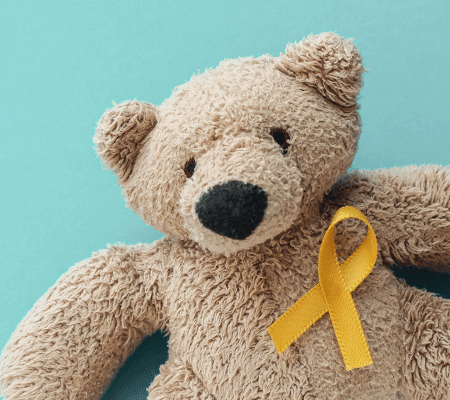
Childhood cancer is one of the most heart-wrenching health diagnoses parents can get for their children. Cancer continues to be the leading cause of death by disease for all children under 14, and about 15,000 children are diagnosed in the U.S. and 300,000 globally each year.
Over the last 50 years, great strides have been made in the treatment of childhood cancer. Survival rates have increased from 20% (50 years ago) to today’s rate of 80%.
Research is key
Childhood leukemia has seen a significant improvement in survival rates over the last 50 years due to research.
“For childhood leukemia, it has to do with clinical trials that lead to a greater understanding of how to use chemotherapy,” said Dr. Michelle Manalang, pediatric hematologist/oncologist with Marshfield Children’s. “Over the last 50 years, the cure rate went from less than 10% to more than 80% using the same chemotherapy drugs because we’ve learned how to use them more effectively. The cure rate of some types of childhood leukemia are over 90%.”
The Children’s Oncology Group is the largest childhood cancer research organization in the world. With more than 200 children’s hospitals participating in the group, cancer clinical trials are able to accrue more patients, finish studies faster and have a larger effect. They conduct research, not only with chemotherapy trials, but investigating the effect of chemotherapy on children, how cancer starts and how it becomes resistant to chemotherapy.
“We are a Children’s Oncology Group member because it allows us to deliver a higher quality of care to our patients,” said Dr. Manalang, who is the principal investigator for Children’s Oncology Group at Marshfield Children’s Hospital. “Clinical trials work by comparing the best treatment, otherwise known as the standard treatment, with potentially better treatments, in a scientific manner.”
Despite these improvements in childhood leukemia, there are still many types of childhood cancers where there has been little increase in survival rates over the last few decades.
Childhood cancer needs more than just treatment
While doctors are there to treat a patient with cancer, chemotherapy is often just one part of their treatment plan. It requires an entire team of specialists to ensure each child is taken care of.
One member of the team that is important is the Certified Child Life Specialist. They give children security, comfort, acceptance and affection using evidence-based practices like therapeutic play, preparation for medical events and opportunities for emotional expression.
“We believe the best way to help a child get through their worst days is by having fun. Play is a child’s work,” said Heidi Giese, Child Life & Expressive Therapies manager for Marshfield Children’s Hospital.
In partnership with doctors and nurses, a child life specialist makes sure a child’s medical experience is easier. They try to help by:
- Minimizing stress and anxiety related to their care.
- Developing a coping plan.
- Enhancing understanding of procedures.
- Providing age-appropriate, safe play environments.
- Enhancing growth in their stage of development and within your family and culture.
- Supporting and helping you participate in your child’s health care.
- Helping your family maintain everyday routines.
One program Child Life at Marshfield Children’s helps to coordinate for children and adolescents going through cancer is the Bravery Bead Program.
At diagnosis, children receive a starter necklace from the Child Life staff. Children can then collect beads that represent different elements of the treatment process to acknowledge their courage throughout their cancer treatment.
“We find this program really allows the child to comprehend what they are going through because it gives us a starting point to talk about each phase of treatment,” Giese said.
Besides Child Life, patients with childhood cancer will see many different specialists through their hospital stay including surgery, radiology, inpatient hospital support, pharmacy and much more. The nursing staff also is often specially-trained to provide chemotherapy and biotherapy.
“Our patients utilize so many different aspects of the hospital. I am really happy that we have all of that here,” Dr. Manalang said.
Life after cancer is important as well
While there is often a lot of focus on treating the cancer, life after cancer can be very important as well. Programs aimed at supporting patients after treatment are often called survivorship.
“In pediatric oncology, we also follow them after they have completed treatment, because we know chemotherapy can have late effects,” said Dr. Manalang.
Some patients can experience hearing loss, fertility issues or issues with their heart or lungs. For example, patients that are treated for leukemia have higher incidence of diabetes and are often more obese. Some late effects may not be diagnosed until years after the completion of chemotherapy. That is why it is important for young adults who are survivors of childhood cancer to be seen at a pediatric cancer survivorship clinic, like the one at Marshfield Children’s.
For more information about childhood cancer, talk to your pediatric hematologist/oncologist.
Related posts
Cancer basics: What you need to know






Leave a Reply